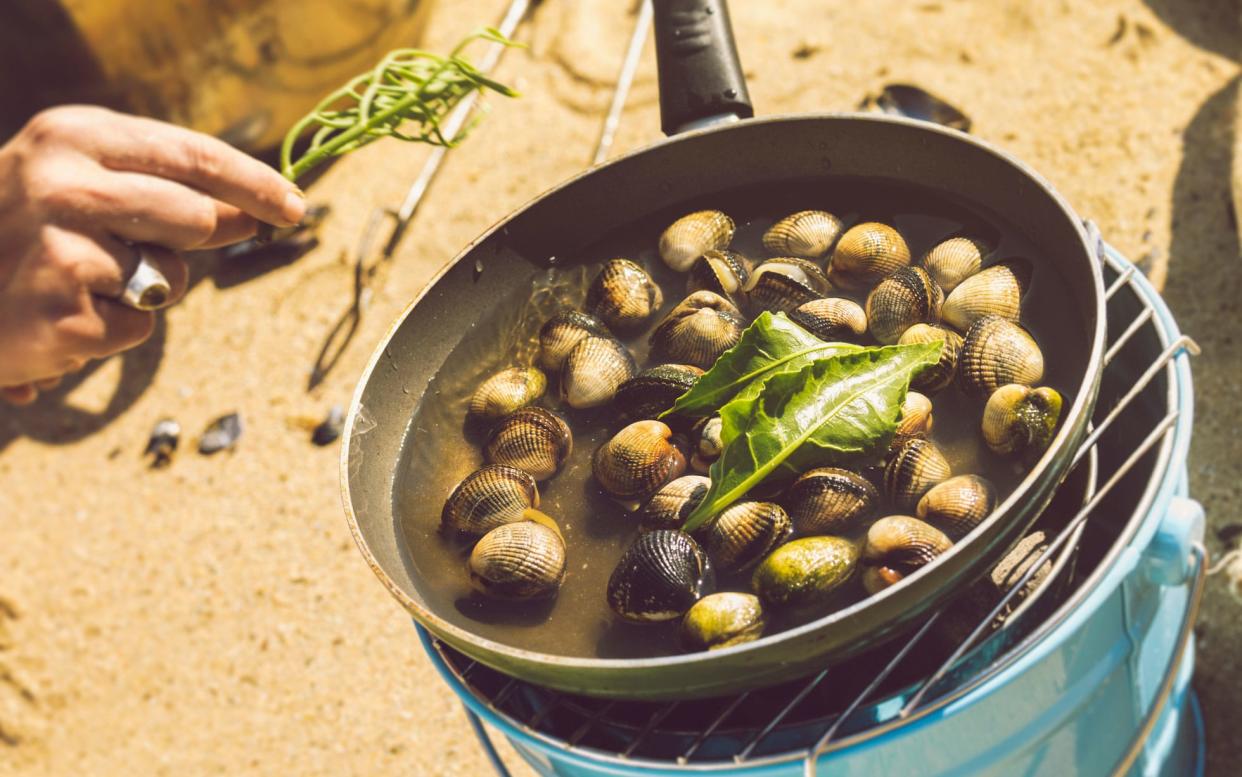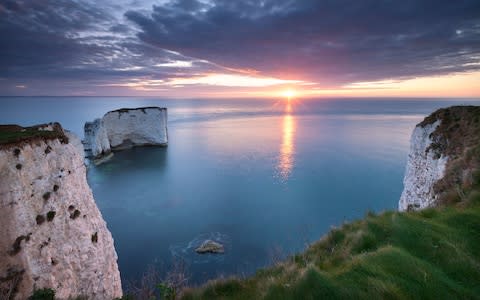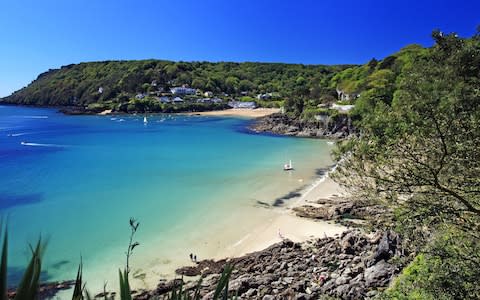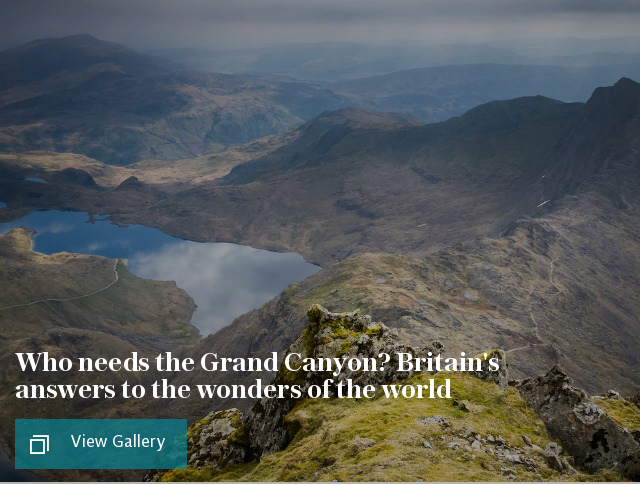The rise of seaside foraging: How to find your own food along the UK coast

Gazing out from Studland’s Middle Beach Café, I breathed in fry-up and seaweed. Ah, the British coast at breakfast time. But this morning, bacon wasn’t on my menu. I looked over the ripples, Bournemouth just visible across the bay, the bright-white sentinels of Old Harry Rocks standing guard to the south, and thought: today, this is my larder.
We’re all thinking more about what we eat. A report by Innova Market Insight identified making more “mindful choices” as 2018’s top food trend. We’re also eating more fish, and even seaweed is gaining popularity. With the added bonus of the sea temperature being so uncharacteristically warm this year, it’s no surprise that seafood experiences are popping up across the UK, encouraging us to get hands-on with everything from lobster to gutweed in all manner of ways.
I’d picked an unfortunately dull day to visit Dorset for my own seaside expedition. But Dan Scott – sailor, bushcrafter, ethnobotanist, wild food fan – remained upbeat. Dan is co-founder of Fore/Adventure, which combines outdoor pursuits with an appreciation of nature’s bounty. Fore can arrange almost anything: fishing from kayaks, coastal forages, seashore safaris by stand-up paddleboard. I’d come to snorkel for spider crabs. I squeezed into a wetsuit and we were off.

I was glad to be wrapped in protective neoprene, and not only against the water’s nip. Our quarry was a tough cookie, with a spiny carapace up to 20cm across, long, pugilistic limbs and fierce claws. Spider crabs aren’t actually dangerous if you know how to handle them, which Dan was going to teach me. And they’re woefully under-appreciated: despite being sweet-fleshed and plentiful in British waters, they’re mostly shipped off for other nations to enjoy. With luck, not on this occasion.
Dan and I headed off along the low cliffs and into the water. It was cold but invigorating, and wonderfully strange; an alien environment on the doorstep. We finned through wiggy seaweed, inched along barnacled rocks and dove down to scour for signs of life – not only crabs but maybe sea spaghetti, limpets or razor clams. Studland Bay is also one of the few places in the UK where you can see wild seahorses, though we certainly wouldn’t be cooking any of those.
Sadly, the murk was a bit too thick. So, giving up on the depths, we returned to loot the littoral. There are about 20 types of edible seaweed – and many more that aren’t poisonous but just don’t taste nice. Dan carefully plucked a tiny frond. “Osmundea pinnatifida – pepper dulse,” he said, handing it over. Hot, salty, delicious. “And there’s some Ulva intestinalis – gutweed – particularly good deep-fried.”
We clambered past periwinkles and bubble-wrappy bladder wrack, honing in on some Ulva lactuca – vivid-green sea lettuce. “We’ll add it to our salad,” Dan said, showing me how to harvest it: use a sharp knife or scissors; cut away only the top third; take small amounts from a wide area rather than one spot.

After a while playing in the water, my bones started to chill and my belly to rumble. The plan was to cook lunch on South Beach, though it took a while to get there. Walking the short access path, Dan kept delving into the verges, a kid in a limitless sweet shop. He picked some sea beet (“nice and tough, a bit like spinach”), citrusy rock samphire and ox-eye daisies, for their edible white petals. I was about to point out what looked like wild parsley, just as Dan turned on it disapprovingly. “That’s hemlock water dropwort, one of the country’s most poisonous plants.” Ah. That’s why you forage with experts.
By the time we reached the quiet beach, our basket brimmed with a wide selection, including wild fennel – “Get your eye in, and you’ll see it everywhere” – and salty sea purslane from the marsh nearby. There was also a bag of Sainsbury’s spinach. “People think we forage for everything,” Dan explained, “but that would take ages. Also, foraging needs to be sustainable. We will take enough to add flavour, no more.”
We found a spot and Dan whipped out our backup crabs (“We always buy some, just in case”), two fine specimens from Swanage Bay Fish, a sustainability-focused family-run fishmonger selling seafood caught along the Dorset coast. I might not have harvested these spiders myself, but at least we’d shared the same waters.
Dan taught me how to pick them up when they’re alive – a scoop-from-behind and flip technique. I practised, which was easy with a dead, compliant crustacean. But feeling its spiky shell and sharp pincers, I shuddered to think of meeting it underwater.

We smoked the crabs on Dan’s portable barbecue, then set about the messy business of demolition. By the time we’d finished, we were ravenous. But the pay-off: a feast, eaten crossed-legged on warm sand, surrounded by sea salt, woodsmoke and the peaceful lap of the waves.
Fore/Adventure offers a range of scheduled and bespoke trips in Studland Bay. Half-day kayak snorkelling trips cost from £60pp, with options to add foraging and wild cooking on the beach costing up to £120pp (01929 761515; foreadventure.co.uk).
10 more seaside foraging adventures
1. Land a lobster, Conwy
Get a taste of the north Wales coast on a lobster safari with skipper, marine biologist and crustacean-catcher Carl Davies. Sailing around the glorious Great Orme, you’ll gain an insight into life on a lobster boat. Back on land, there’s the chance to buy fresh lobster and crab to take home for your supper.
Two-hour trips cost from £25/£17 per adult/under-16. Sea Fishing Trips in North Wales (01492 572707; sea-fishing-trips.co.uk)

2. Forage by paddleboard, Hampshire
Spend the evening stand-up paddleboarding on calm Keyhaven harbour, foraging as you go. Trips start at 5pm. After a quick lesson, row your way towards Hurst Castle on beginner-friendly boards, accompanied by local chef Jesse Wells. After a gentle float, gathering samphire, sea herbs and other wild treats, moor up at the Henry VIII-built ramparts, where Jesse will cook your bounty with some locally-caught-that-day fish. Then tuck in as the sun sinks into the Solent.
The evening Foraging Experience costs £150pp. New Forest Paddle Sport Company (01590 645270; thenewforestpaddlesportcompany.co.uk)
3. Get the kids cooking, Pembrokeshire
New for 2018, to celebrate Wales’s Year of the Sea, Wild About Pembrokeshire has created a seashore foraging and beach-fire cooking course aimed at kids. Accompanied by qualified guides, junior foodies will learn all about the coastal larder, searching the rock pools and shallows near St Davids for molluscs, crabs, edible plants and a range of seaweeds. They’ll then learn how to safely prepare and cook what they’ve found on a campfire before eating the results.
Two-hour courses cost £14.50/£4 per adult/child (six-15 years). Wild About Pembrokeshire (wildaboutpembrokeshire.co.uk)

4. Hook a mackerel, Yorkshire
Hop aboard with fisherman Sean Baxter to catch, cook and consume your own lunch in the North York Moors National Park. Sail from Staithes harbour to a nearby reef, where Sean will show even amateur anglers how to cast a line and land mackerel. Keep an eye out for seabirds and porpoises too. Back on shore, learn how to clean and prepare your fish before smoking and eating it – sea to stomach in just over an hour.
Three/four-hour Mackerel Hook & Cook trips cost from £35pp. Real Staithes (01947 840278; realstaithes.com)
5. Get in before Gordon, Ross-shire
Afloat on Gair sea loch, with the Torridon Mountains an imposing backdrop, Dry Island has long been a base for fishermen harvesting these waters. Ian McWhinney, the island owner, now allows passengers to hop aboard his traditional creel fishing boat so they can explore the inlet with him, looking out for dolphins, seals and seabirds, and watching the wicker baskets being hauled in full of langoustine, prawns, octopus and crab – some of which are bound for Gordon Ramsay’s restaurants.
A two-hour trip costs £17.50/£12.50 per adult/child. Shellfish Safaris (01445 741263; shellfishsafaris.co.uk)

6. Start smoking, Suffolk
Savour Suffolk through its seafood on a Tastes of Orford trip. The day begins at the local-produce-packed Suffolk Food Hall, before a short coastal walk and a rowboat trip across the Butley river deposits you at Bill Pinney’s smokehouse and oysterage. Discover how Bill uses oak logs to smoke his mackerel, cod roe, trout and sardines the traditional way, watch experts shuck oysters grown in the local creek and tuck in to a mighty seafood lunch.
The one-day Tastes of Orford tour costs from £85pp. Private tours available on request. Suffolk Heritage Food Tours (07479 525595; suffolkheritagefoodtours.com)
7. Make it to market, Devon
So fabulously fishy is south Devon’s Riviera that it’s branded itself England’s Seafood Coast. Indeed, more than £25 million of fish is landed and sold at Brixham Fish Market each year. Anyone can experience all the pungent action of the auction by joining an early morning tour – just be prepared for a 6am start and to don overalls and hairnets. Tours finish with a fisherman’s fry – egg, bacon, smoked haddock, scallops and fish of the day – at Mitch Tonks’s Rockfish restaurant upstairs.
Two-hour Fish Market tours cost £15. To book, email bfmt2014@gmail.com. English Riviera (01803 211211; englishriviera.co.uk)

8. Crack a crab, Dorset
Tupperware parties are so last century! Now, get your mates round for an evening of seafood demolition instead. Abbotsbury-based Sally’s Fish Camp, which home-delivers fresh seafood by the bag and bucket, will also come to your kitchen to teach a Crab Cracking Workshop. Learn how to handle, destroy, pick apart and dress one of these tricksy crustaceans, while enjoying a glass of wine and tasty crab canapés. Come away with new skills, recipe ideas and your own cook-ready crab.
Two-hour workshops cost £25pp, based on groups of eight to 10. Sally’s Fish Camp (07969 397512; sallysfishcamp.co.uk)
9. Bring in your breakfast, Northern Ireland
Sailing out of Portrush Harbour at 6.45am is a splendid way to start the day: you can watch the sun rising over the Mull of Kintyre and might spot dolphins and basking sharks. The aim of the Catch & Sea trip, though, is to source your own sustenance – tuition and equipment is supplied. Back on land, learn how to clean your haul, before heading to waterside Babushka café, who’ll turn it into a hearty breakfast
Three-hour Catch & Sea trips cost £55pp. Causeway Coast Foodie Tours (07912 408256; causewaycoastfoodietours.com)

10. Cook like a pro, Cornwall
Whatever you think of Rick Stein’s colonisation of Padstow, the man knows his fish. And his Seafood School’s Catch & Cook course can help other would-be chefs get better acquainted with it, too. Spend a morning on the Camel Estuary with local fisherman Lee Wicks before returning to the professional kitchen to learn filleting and griddling techniques and to make a couple of Rick’s dishes with your catch, such as mackerel with piriñaca salad.
The one-day Catch & Cook course costs from £198. Rick Stein’s Cookery School (01841 532700; rickstein.com)


